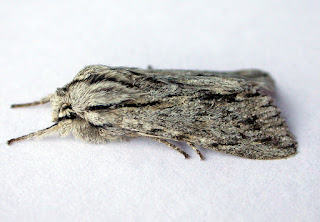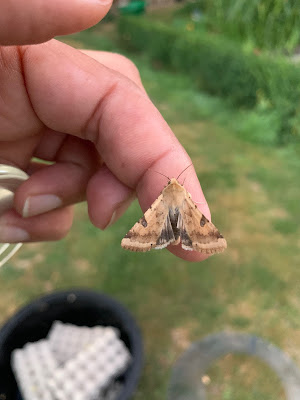Saturday, 31 December 2022
New Year's Eve trio
Wednesday, 21 December 2022
Stowe moths 2022
At the end of 2022, my third year of moth recording, the
garden total now stands at 517. The total for the year was 436, of which 102
were new, (38 macro, 64 micro). Light trapping was done on 174 nights with a
20W actinic and a 120W MV—some nights with both, but on a number of nights just
the MV, whilst the actinic was deployed off-site in local woodland. Best night
was 17 July with 350 moths of 100 species across the two traps.
Lunar Underwing returned to being the most numerous species, having
dropped to #6 in the ranking last year. Square-spot Rustic has
rapidly climbed the ranks from 12th place in 2020, to 7th
last year, to second most numerous in 2022. Most numerous micro was Chrysoteuchia
culmella as it has been every year.
Highlights included: Evergestis limbata, a first for Bucks,
and based on iRecord data this seems to be the furthest NW UK sighting, apart
from a couple of sites in Leicestershire, one of which seems to have recorded
the species almost annually for the past five years.
Clifden Nonpareil, (finally!); Dusky-lemon Sallow, with only one prior (1963) record in the whole of northwest Bucks up to the end of 2020; and three new clearwing species—Sallow Clearwing, Currant Clearwing and Hornet Moth, (with exit holes of the latter found in the base of a mature poplar), bringing the garden clearwing total to eight species.
As to migrants, several Rusty-dot Pearls and Vestals put in an appearance, both new to the garden, with the latter apparently being the first records for the hectad according to the Atlas. It was also good to add some more identified cnephasia and coleophora species to the list, thanks to Peter, as well as a few expected species that had not so far put in an appearance, such as Twenty-plume Moth, Blossom Underwing, Peach Blossom, Bright-line Brown-eye, and Ear Moth. Still plenty to go at though!
Monday, 19 December 2022
A moth!
Even though it became very windy, the significant increase in temperature last night meant that it was worth trying the actinic light again for the first time in nearly a fortnight and, as luck would have it, a single moth appeared:
 |
| Acleris ferrugana/notana, Westcott 18th December |
This will undoubtedly be ferrugana which is a regular at Westcott and is far more widespread than notana (I've never had the latter in the garden and in Bucks at least it is restricted to sites with a lot of birch, so Bernwood is probably my closest known colony). However, rather than recording it as the aggregate this one will be checked because I've not seen it here this year. When its identity is known for sure it will become species number 743 for the 2022 garden list.
Dave Wilton Westcott, Bucks
Saturday, 17 December 2022
E-moth Newsletter
The latest issue of Butterfly Conservation's E-moth newsletter can be read here. Amongst other things, it contains information about the annual Moth Recorders' Meeting which will be held at the end of January (via Zoom).
Tuesday, 13 December 2022
2022 in numbers: Worminghall, Bucks
Wednesday, 7 December 2022
Westcott, Bucks
 |
| Scarce Umber, Mottled Umber & Winter Moth Westcott 3rd December |
Tuesday, 6 December 2022
Winter or Northern Winter?
These specimens (amongst others) turned up on Monday night. Does No 4 have pale enough hind wings to make in Northern? I imagine the others are Winter moth. Thanks, David
Monday, 5 December 2022
Acleris sparsana
Friday, 2 December 2022
Moth Dissection website
This is a request for those that use the Moth Dissection website either directly or indirectly, to consider sponsoring the site . I make this plea every year so that we can cover the running costs and keep it going. There's been an astonishing number of new dissection images as well as adult, larval and other stages posted. Every day new images appear. So please consider helping to keep it going. Thank you. Peter Hall
Thursday, 1 December 2022
2022 in Numbers: Westcott
Tuesday, 29 November 2022
Conistra rubiginosa returns
Very little in trap, but the first Conistra rubiginosa for the year in Denham - as usual undeterred by a cold night (Nov. 28-29). So keep those traps working from time to time, and ignore the temperature!
Absent Mottled Umbers
I have had neither Mottled, nor Scarce ditto this year; and none in local woods either. Is this a common experience elsewhere?
Plutella xylostella?
I think this is Plutella xylostella, as there is just a hint of the dorsal pattern, and the overall "jizz" looks right, but would appreciate comments!
Thanks
Phil T
Saturday, 26 November 2022
Westcott, Bucks
 |
| Zelleria hepariella, Westcott 23rd November |
 |
| Sprawler, Westcott 24th November |
 |
| Silver Y, Westcott 25th November |
Wednesday, 23 November 2022
Just when I think . . . . .
. . . . .that I'm getting the hang of some basic micros, this turns up. Came to light on Sept 3rd near Chesham- can't find anything that looks like it in the books. Someone please put me out of my misery?
Thanks, David
Sunday, 20 November 2022
Earlier in the year
On the 4th August, this smart micro turned up in Stoke Goldington. Looks (to me at least) a candidate for Bryotropha basaltinella, but would need the chop to be sure?
Saturday, 19 November 2022
Westcott, Bucks
 |
| Scarce Umber, Westcott 18th November |
 |
| Turnip Moth, Westcott 14th November |
Tuesday, 15 November 2022
Diplopseustis perieresalis
A Diplopseustis perieresalis was attracted to our house lights (Loosley Row) last night. I see, going back through the blog that Dave caught one in 2016.
Nigel
Sunday, 13 November 2022
Zelleria oleastrella
Zelleria oleastrella to mv in Denham last night. Robin. Photo can follow. Retained.
Saturday, 12 November 2022
Two 'plume' species
Hi there,
These two turned up on Thursday night near Chesham - outside the Robinson on an adjacent white-painted door. From Page 92 in the Berkshire book, I make the first one Stenoptilia bipunctidactyla, but it looks nothing like the illustration of the same species in Sterling and Parsons.
And is the second one just a dark form of Emmelina monodactyla? The first insect was quite a bit bigger than the second.
If I'm right, then are both flying later in the year than usual - maybe due to the mild weather??
Thanks, David
Vagrant China-mark, Diasemiopsis ramburialis, Worminghall. A first for Bucks.
Very pleased to finally catch a decent autumn migrant this morning. Was even more pleased (and surprised) to find out it's a county first too.
Thanks very much to Dave and Martin for confirming.
Plumed Prominent
I trapped at Warburg last night with 3x 125w Robinson MV and an 8w actinic, from 17.15 to 20.45 when the moon pretty much killed it. There were 17 Plumed Prominents, all males. 19 species, including a late Metalampra italica and 2 migrants, Plutella xylostella and Nomophila noctuella.
Friday, 11 November 2022
Plumed Prominent
 |
| Plumed Prominent, Homefield Wood 10th November |
Wednesday, 9 November 2022
Which Agriphila?
This has waited since 23rd August - well, I've been busy. I'm thinking probably tristella, but could it be straminella?
Many thanks, David
Scarce Umber
 |
| Scarce Umber, Westcott 8th November |
Tuesday, 8 November 2022
Crimson Speckled & Plumed Prominent in Bucks
Monday, 7 November 2022
A Berkshire Migrant
Three moths of three species last night. Eudonia angustea and Red-green Carpet were not unexpected but this one was a surprise.
Ben Dale on the Berkshire Moth Group Facebook page has kindly confirmed it as Diasemiopsis ramburialis
Sunday, 6 November 2022
Another garden newcomer
 |
| Povolnya leucapennella, Westcott 5th November |
 |
| Bedellia somnulentella, Westcott 5th November |
Saturday, 5 November 2022
Could this be a Delicate?
Friday, 4 November 2022
The End is Nigh
 |
| Winter Moth, Westcott 3rd November |
Dave Wilton Westcott, Bucks
Thursday, 3 November 2022
Tortrix for ID
This is my first season recording micros although in the past I did extensively record macros when living in Cambridgeshire and Cheshire.
I am working through a few outstanding records from earlier in the year and would appreciate comments on these three. On the 31st of July I caught this one and posted the picture on the Berkshire Moth Group Facebook page but no one suggested an ID. I then posted it on the UK Micro Moth page and Ben Sale suggested Rhopobota stagnana which appears to be a fairly rare moth in the County.
Then on the 3rd August I caught this one and didn't recognise it as the same thing - there were a lot of moths in the trap late July and early August although looking now it certainly looks like the same thing.
Worminghall, Bucks
Unfortunately no mega migrant here during the recent influx (although I did desert my post for a few days and headed to the coast to find some). Highlight was an Oak Rustic (the first for the garden) and a few nice migrants including 2 Delicates, up to 17 Rush Veneer in one night (30th October), a Vestal, a Diamond-back and a couple of Rusty-dot Pearls. Also a late Clifden Nonpariel on 25th October and a few new for years including Sprawler and December moth and another potential new for garden in the form of an Acleris kochiella/logiana (awaiting dissection) which takes the 2022 garden year list to 492 (unverified).


































.JPG)


.JPG)
